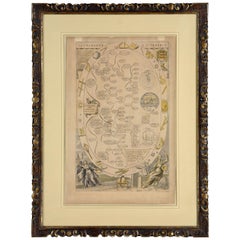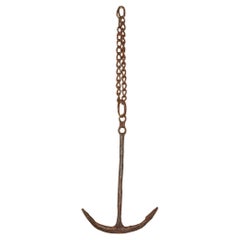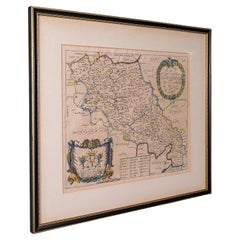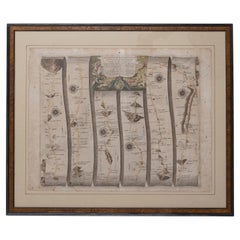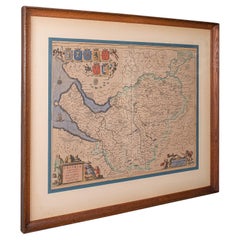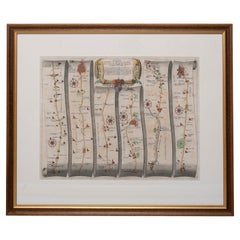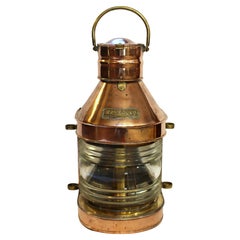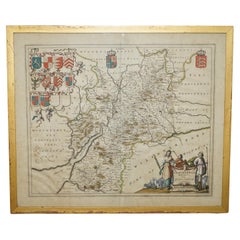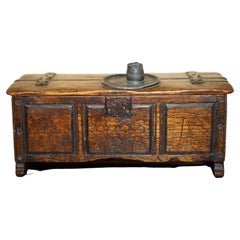Charles II Collectibles and Curiosities
to
9
9
2,013
913
861
809
573
471
342
277
244
207
146
126
99
63
59
49
42
38
9
8
2
2
1
1
9
8
3
1
9
9
9
1
Style: Charles II
Cosmgraphy and Astrology, 1686 by Richard Blome from the First Edition
Located in BUNGAY, SUFFOLK
Cosmography & Astrology
Large oval engraved plate with inscriptions outlining the various parts of cosmography and astronomy; below, two emblematic figures with scientific instruments either side. Lettered with title, dedication, and various inscriptions. To his Excellency Roger Palmer, Earle of Castelmain and Baron of Limerick in Ireland, Embassador Extraordinary from his majesty King James II to his Holyness Pope Innocent 11th anno dom 1686. This plate is humbly DD by Richard Blome. On paper and retaining its original coloring.
Sheet width 26 ½ cm., 10 ½ in., height 41 ½ cm., 16 ½ in.,
In a part-gilded Sansovino frame...
Category
1680s English Antique Charles II Collectibles and Curiosities
Materials
Paper
ANTIQUE CIRCA 1640 ORIGINAL HEAVILY WORN ENGLISH SHIP's ANCHOR FROM PENZANCE
Located in West Sussex, Pulborough
Royal House Antiques
Royal House Antiques is delighted to offer for sale this absolutely stunning and totally original, folded iron Ships Anchor dati...
Category
1640s English Antique Charles II Collectibles and Curiosities
Materials
Iron
Antique County Map, Northamptonshire, English, Framed Cartography, Richard Blome
Located in Hele, Devon, GB
This is an antique county map of Northamptonshire. An English, framed atlas engraving by Richard Blome, dating to the 17th century and later.
Fascinating cartography, oriented 90 d...
Category
Late 17th Century British Antique Charles II Collectibles and Curiosities
Materials
Glass, Wood, Paper
Road Map Britannia No 32 the Road from London to Barnstable John Ogilby Framed
By John Ogilby
Located in BUNGAY, SUFFOLK
A road map from Britannia, by John Ogilby Esq., Cosmographer and Geographick Printer to Charles II. Containing 293 miles. No 32.
From Standard in Cornhill London to Andover thence to Amesbury, to Shruton, to Warminster, to Maiden-Bradley, to Bruton, to Weston, to Ascot and to Bridgewater
Hand coloured, some foxing and creasing, commensurate with age.
Floated in a cream mount with a gilded linear border within a burr walnut, ebonised and gilded frame.
Provenance : purchased as pair from a collector with no 15 London to St Davids. Framed as a pair.
Measures: Black Linear Border around Map Length 44cm., 17 1/8" Height 36cm., 14".
Full Sheet Length 51cm., 20" Height 39cm., 15 1/4"
Frame Length 62cm., 24 1/2 " Height 52cm., 20 1/2"
Literature: In a remarkable life John Ogilby pursued, several careers, each ending in misfortune, and yet he always emerged undeterred, to carry on. His modern reputation is based on his final career, started in his sixty-sixth year, as a publisher of maps and geographical accounts.
Ogilby was born outside Dundee, in 1600, the son of a Scottish gentleman. While he was still a child, the family moved to London. When the elder Ogilby was imprisoned for debt, the young John invested his savings in a lottery, won a minor prize, and settled his father's debts. Unfortunately, not enough money was left to secure John a good apprenticeship; instead, he was apprenticed to a dance master. Ogilby was soon dancing in masques at court but, one day, while executing a particularly ambitious leap, he landed badly. The accident left him with a permanent limp, and ended his dancing career. However, he had come to the attention of Thomas Wentworth, later Earl of Strafford, Charles I's most senior minister. Ever one to exploit his contacts, Ogilby became a dance instructor in Strafford's household.
When Strafford was sent to Ireland, Ogilby accompanied him as Deputy-Master of the Kings Revels, and then Master of Revels. In Dublin, he built the New Theatre, in St. Werburgh Street, which prospered at first, but the Irish Rebellion, in 1641, cost Ogilby his fortune, which he estimated at £2,000, and almost his life. After brief service as a soldier, he returned to England, survived shipwreck on the way, and arrived back penniless.
On his return, Ogilby turned his attention to the Latin classics, as a translator and publisher. His first faltering attempt, in 1649, was a translation of the works of Virgil, but after his marriage to a wealthy widow the same year, his publishing activities received a considerable boost. One means by which Ogilby financed these volumes was by subscription, securing advance payments from his patrons, in return for including their name and coats-of-arms on the plates of illustrations. Another approach was to secure a patron, preferably in the court circle. Ogilby's first patron was Strafford, who found out too late that all leading ministers are dispensable when Charles I assented to his execution in 1641. As he re-established himself, Ogilby sought a new patron, the King himself.
In 1661, Ogilby was approached to write poetry for Charles II's coronation procession; he later published 'The Relation of His Majesties Entertainment Passing Through the City of London', and a much enlarged edition the following year, which included a Fine set of plates depicting the procession. Royal favour was bestowed in 1674 when John Ogilby received the title of 'His Majesty's Cosmographer and Geographick Printer' with a salary of £13.6s.8d per annum.
In 1665, Ogilby left London to avoid the Plague then ravaging the capital. The following year, in the Great Fire of London, Ogilby claimed that he lost his entire stock of books valued at some £3,000, as well as his shop and house, leaving him worth just £5.
As he sought to restore his fortunes, Ogilby was already looking in new directions. The initial opportunity he seized on was the reconstruction of London's burnt-out centre. He secured appointment as a 'sworn viewer', whose duty was to establish the property boundaries as they existed before the Fire. Ogilby was assisted in the project by his step-grandson, William Morgan...
Category
Late 17th Century English Antique Charles II Collectibles and Curiosities
Materials
Paper
Antique County Map of Cheshire, Dutch, Framed, Cartography, Janssonius, C.1660
Located in Hele, Devon, GB
This is an antique county map of Cheshire. A Dutch, framed atlas engraving by Johannes Janssonius, dating to the 17th century and later.
A treat for the collector or county native,...
Category
Mid-17th Century Dutch Antique Charles II Collectibles and Curiosities
Materials
Glass, Wood, Paper
Road Map No43 London to Kings Lynn, Royston to Downham, John Ogilby, Britannia
By John Ogilby
Located in BUNGAY, SUFFOLK
John Ogilby (British 1600-1676) Cosmographer and Geographick Printer to Charles II.
A road map from Britannia, 1675/6. The road from London to Kings Lynn, showing Royston to Downham. In oak and gilded frame.
In a remarkable life John Ogilby pursued, several careers, each ending in misfortune, and yet he always emerged undeterred, to carry on. His modern reputation is based on his final career, started in his sixty-sixth year, as a publisher of maps and geographical accounts.
Ogilby was born outside Dundee, in 1600, the son of a Scottish gentleman...
Category
Late 17th Century British Antique Charles II Collectibles and Curiosities
Materials
Paper
Road Map Britannia No 15 London to St Davids John Ogilby Brown Gilt Frame
By John Ogilby
Located in BUNGAY, SUFFOLK
The continuation of the road from London to St Davids, commencing at Abingdon Com Berks and extending to Monmouth By John Ogilby Esq, His Majesties Cosmographer. From Abingdon to Farringdon, to Lechlade, to Fairford, to Barnsley to Gloucester showing Monmouth as the destination. A road map from Britannia, 1675/6. No 15.
Hand coloured and floated on a cream mount within a brown painted and gilded ogee frame. Some foxing and creasing, uneven edge of sheet, all commensurate with age
Provenance : purchased as pair from a collector with no 25 London to Lands End. Framed as a pair.
Sheet width 46.5cm., 18 ¼ ”., height 37.5cm., 14 ¾ “
Frame width 66.5cm., 26”., height 56cm., 22 ”
In a remarkable life John Ogilby pursued, several careers, each ending in misfortune, and yet he always emerged undeterred, to carry on. His modern reputation is based on his final career, started in his sixty-sixth year, as a publisher of maps and geographical accounts.
Ogilby was born outside Dundee, in 1600, the son of a Scottish gentleman. While he was still a child, the family moved to London. When the elder Ogilby was imprisoned for debt, the young John invested his savings in a lottery, won a minor prize, and settled his father's debts. Unfortunately, not enough money was left to secure John a good apprenticeship; instead, he was apprenticed to a dance master. Ogilby was soon dancing in masques at court but, one day, while executing a particularly ambitious leap, he landed badly. The accident left him with a permanent limp, and ended his dancing career. However, he had come to the attention of Thomas Wentworth, later Earl of Strafford, Charles I's most senior minister. Ever one to exploit his contacts, Ogilby became a dance instructor in Strafford's household.
When Strafford was sent to Ireland, Ogilby accompanied him as Deputy-Master of the Kings Revels, and then Master of Revels. In Dublin, he built the New Theatre, in St. Werburgh Street, which prospered at first, but the Irish Rebellion, in 1641, cost Ogilby his fortune, which he estimated at £2,000, and almost his life. After brief service as a soldier, he returned to England, survived shipwreck on the way, and arrived back penniless.
On his return, Ogilby turned his attention to the Latin classics, as a translator and publisher. His first faltering attempt, in 1649, was a translation of the works of Virgil, but after his marriage to a wealthy widow the same year, his publishing activities received a considerable boost. One means by which Ogilby financed these volumes was by subscription, securing advance payments from his patrons, in return for including their name and coats-of-arms on the plates of illustrations. Another approach was to secure a patron, preferably in the court circle. Ogilby's first patron was Strafford, who found out too late that all leading ministers are dispensable when Charles I assented to his execution in 1641. As he re-established himself, Ogilby sought a new patron, the King himself.
In 1661, Ogilby was approached to write poetry for Charles II's coronation procession; he later published 'The Relation of His Majesties Entertainment Passing Through the City of London', and a much enlarged edition the following year, which included a fine set of plates depicting the procession. Royal favour was bestowed in 1674 when John Ogilby received the title of 'His Majesty's Cosmographer and Geographick Printer' with a salary of £13.6s.8d per annum.
In 1665, Ogilby left London to avoid the Plague then ravaging the capital. The following year, in the Great Fire of London, Ogilby claimed that he lost his entire stock of books valued at some £3,000, as well as his shop and house, leaving him worth just £5.
As he sought to restore his fortunes, Ogilby was already looking in new directions. The initial opportunity he seized on was the reconstruction of London's burnt-out centre. He secured appointment as a "sworn viewer", whose duty was to establish the property boundaries as they existed before the Fire. Ogilby was assisted in the project by his step-grandson, William Morgan...
Category
Late 17th Century British Antique Charles II Collectibles and Curiosities
Materials
Paper
Road Map Britannia No 25 London to the Lands End, John Ogilby Brown Gilded Frame
By John Ogilby
Located in BUNGAY, SUFFOLK
The road from London to the lands end. Commencing at the Standard in Cornhill and extending to Senan in Cornwall. By John Ogilby His Majesties Cosmographer. A road map from Britannia, 1675/6. No 25.
Continuing 308 miles, 3 furlongs.
London Southwark to Brentford, to Hampton Court, to Hounslow, to Windsor, to Cobham, to Farnham, to Basingstoke to Winchester
The handcoloured sheet free floated. In a brown painted and gilded, ogee moulded frame. Some foxing and creasing, uneven edge of sheet, all commensurate with age
Provenance : purchased as pair from a collector with no 15 London to St David's. Framed as a pair.
Sheet width 48cm., 19 ”., height 38cm., 15 “
Frame width 66.5cm., 26”., height 56cm., 22 ”
In a remarkable life John Ogilby pursued, several careers, each ending in misfortune, and yet he always emerged undeterred, to carry on. His modern reputation is based on his final career, started i
Black Linear Border around Map Length 44cm., 17 1/8" Height 32cm., 12 1/2"
Full Sheet Length 58cm., 22 3/4" Height 38cm., 15"
Frame Length 66cm., 26"., Height 56cm., 22"
In a remarkable life John Ogilby pursued, several careers, each ending in misfortune, and yet he always emerged undeterred, to carry on. His modern reputation is based on his final career, started in his sixty-sixth year, as a publisher of maps and geographical accounts.
Ogilby was born outside Dundee, in 1600, the son of a Scottish gentleman. While he was still a child, the family moved to London. When the elder Ogilby was imprisoned for debt, the young John invested his savings in a lottery, won a minor prize, and settled his father's debts. Unfortunately, not enough money was left to secure John a good apprenticeship; instead, he was apprenticed to a dance master. Ogilby was soon dancing in masques at court but, one day, while executing a particularly ambitious leap, he landed badly. The accident left him with a permanent limp, and ended his dancing career. However, he had come to the attention of Thomas Wentworth, later Earl of Strafford, Charles I's most senior minister. Ever one to exploit his contacts, Ogilby became a dance instructor in Strafford's household.
When Strafford was sent to Ireland, Ogilby accompanied him as Deputy-Master of the Kings Revels, and then Master of Revels. In Dublin, he built the New Theatre, in St. Werburgh Street, which prospered at first, but the Irish Rebellion, in 1641, cost Ogilby his fortune, which he estimated at £2,000, and almost his life. After brief service as a soldier, he returned to England, survived shipwreck on the way, and arrived back penniless.
On his return, Ogilby turned his attention to the Latin classics, as a translator and publisher. His first faltering attempt, in 1649, was a translation of the works of Virgil, but after his marriage to a wealthy widow the same year, his publishing activities received a considerable boost. One means by which Ogilby financed these volumes was by subscription, securing advance payments from his patrons, in return for including their name and coats-of-arms on the plates of illustrations. Another approach was to secure a patron, preferably in the court circle. Ogilby's first patron was Strafford, who found out too late that all leading ministers are dispensable when Charles I assented to his execution in 1641. As he re-established himself, Ogilby sought a new patron, the King himself.
In 1661, Ogilby was approached to write poetry for Charles II's coronation procession; he later published 'The Relation of His Majesties Entertainment Passing Through the City of London', and a much enlarged edition the following year, which included a fine set of plates depicting the procession. Royal favour was bestowed in 1674 when John Ogilby received the title of 'His Majesty's Cosmographer and Geographick Printer' with a salary of £13.6s.8d per annum.
In 1665, Ogilby left London to avoid the Plague then ravaging the capital. The following year, in the Great Fire of London, Ogilby claimed that he lost his entire stock of books valued at some £3,000, as well as his shop and house, leaving him worth just £5.
As he sought to restore his fortunes, Ogilby was already looking in new directions. The initial opportunity he seized on was the reconstruction of London's burnt-out centre. He secured appointment as a "sworn viewer", whose duty was to establish the property boundaries as they existed before the Fire. Ogilby was assisted in the project by his step-grandson, William Morgan...
Category
Late 17th Century British Antique Charles II Collectibles and Curiosities
Materials
Paper
Road Map Britannia 1675/6 No 5 Road London to Barwick, London Stilton Grey Frame
By John Ogilby
Located in BUNGAY, SUFFOLK
John Ogilby (British 1600-1676) cosmographer and geographick printer to Charles II.
A road map from Britannia, 1675/6. No 5, The road from London to Barwick: London to Stilton
In a grey painted and gilded frame.
In a remarkable life John Ogilby pursued, several careers, each ending in misfortune, and yet he always emerged undeterred, to carry on. His modern reputation is based on his final career, started in his sixty-sixth year, as a publisher of maps and geographical accounts.
Ogilby was born outside Dundee, in 1600, the son of a Scottish gentleman. While he was still a child, the family moved to London. When the elder Ogilby was imprisoned for debt, the young John invested his savings in a lottery, won a minor prize, and settled his father's debts. Unfortunately, not enough money was left to secure John a good apprenticeship; instead, he was apprenticed to a dance master. Ogilby was soon dancing in masques at court but, one day, while executing a particularly ambitious leap, he landed badly. The accident left him with a permanent limp, and ended his dancing career. However, he had come to the attention of Thomas Wentworth, later Earl of Strafford, Charles I's most senior minister. Ever one to exploit his contacts, Ogilby became a dance instructor in Strafford's household.
When Strafford was sent to Ireland, Ogilby accompanied him as Deputy-Master of the Kings Revels, and then Master of Revels. In Dublin, he built the New Theatre, in St. Werburgh Street, which prospered at first, but the Irish Rebellion, in 1641, cost Ogilby his fortune, which he estimated at £2,000, and almost his life. After brief service as a soldier, he returned to England, survived shipwreck on the way, and arrived back penniless.
On his return, Ogilby turned his attention to the Latin classics, as a translator and publisher. His first faltering attempt, in 1649, was a translation of the works of Virgil, but after his marriage to a wealthy widow the same year, his publishing activities received a considerable boost. One means by which Ogilby financed these volumes was by subscription, securing advance payments from his patrons, in return for including their name and coats-of-arms on the plates of illustrations. Another approach was to secure a patron, preferably in the court circle. Ogilby's first patron was Strafford, who found out too late that all leading ministers are dispensable when Charles I assented to his execution in 1641. As he re-established himself, Ogilby sought a new patron, the King himself.
In 1661, Ogilby was approached to write poetry for Charles II's coronation procession; he later published 'The Relation of His Majesties Entertainment Passing Through the City of London', and a much enlarged edition the following year, which included a Fine set of plates depicting the procession. Royal favour was bestowed in 1674 when John Ogilby received the title of 'His Majesty's Cosmographer and Geographick Printer' with a salary of £13.6s.8d per annum.
In 1665, Ogilby left London to avoid the Plague then ravaging the capital. The following year, in the Great Fire of London, Ogilby claimed that he lost his entire stock of books valued at some £3,000, as well as his shop and house, leaving him worth just £5.
As he sought to restore his fortunes, Ogilby was already looking in new directions. The initial opportunity he seized on was the reconstruction of London's burnt-out centre. He secured appointment as a "sworn viewer", whose duty was to establish the property boundaries as they existed before the Fire. Ogilby was assisted in the project by his step-grandson, William Morgan, and by a number of professional surveyors. The result was an outstanding plan of London, on a scale of 100 feet to an inch, on 20 sheets, although it was not printed until after Ogilby's death.
Ogilby then turned his attention to publishing geographical descriptions of the wider-world. In 1667, he issued 'An Embassy from the East India Company of the United Provinces to the Grand Tartar Cham, Emperor of China.' Buoyed by the response to this volume, Ogilby conceived an ambitious project, a multi-volume description of the world. The volumes were joint collaborations, in conjunction with the Dutch publisher Jacob van Meurs. 'Africa', published in 1670, was the least original of the three, both in terms of the text, maps and illustrations. In a similar vein, he issued the 'Atlas Japannensis' (1670), the 'Atlas Chinensis' (1671), and 'Asia' (1673). In 1671, Ogilby published the 'America', translated from Arnold Montanus' Dutch text. The 'America' is certainly the most original, and most important, of Ogilby's various geographical volumes, and its influence and popularity was immediate.
With its completion, Ogilby turned to a project nearer his heart, the description of Britain. Ogilby originally intended to devote one volume to Britain, but as the project evolved, he became more ambitious, as revealed in a prospectus issued in about 1672:
"This having oblig'd our Author to take new Measures ... to compleat within the space of two Years a Work ... considering the Actual survey of the Kingdom, the Delineation and Dimensuration of the Roads, the Prospects and Ground plots of Cities, with other Ornamentals ... into six fair volumes. The Four first comprehending the historical and geographical description of England, with the County-Maps truly and actually survey'd. ... The fifth containing an Ichnographical and Historical Description of all the Principal Road-ways in England and Wales, in two hundred copper sculptures, after a new and exquisite method. The sixth containing a New and Accurate Description of the famous City of London, with the perfect Ichnography thereof ..."
In the proposals, Ogilby emphasised the scale of the undertaking; no-one before him had attempted such a vast project. He estimated the total costs would be £20,000, a staggering amount. The cost of the complete set of six volumes was to be £34. At that time, Wenceslas Hollar...
Category
Late 17th Century British Antique Charles II Collectibles and Curiosities
Materials
Paper
Related Items
Circa 1920s English Ship's Masthead Lantern
Located in Chapel Hill, NC
Circa 1920s ship's masthead lantern, English. A fine example of copper with brass fittings & heavy molded clear glass panel. Retains the likely original oil lmap on copper sliding pa...
Category
1920s English Vintage Charles II Collectibles and Curiosities
Materials
Brass, Copper
Antique Map of the North Sea From the English Channel to Norway & Sweden, 1746
Located in Langweer, NL
Antique map titled 'A correct Chart of the German Ocean from the North of Scotland to the Start Point, on the Coast of Great Britain; and from So. Bygden on ye coast of Norway, to C....
Category
1740s Antique Charles II Collectibles and Curiosities
Materials
Paper
$462 Sale Price
20% Off
H 20.08 in W 15.75 in D 0 in
Weighted Wood Chess Set by John Jaques of London in Wood Box 7cm Kings, ca 1950
Located in Lincoln, Lincolnshire
This is a good and complete English handmade wood "weighted" chess set game of 32 pieces, in its original box with a sliding lid, made by John Jaques of London and dating to the mid 20th century period.
The chess pieces are made of turned and carved varnished wood. The bases of ALL pieces are weighted with metal pieces and the bases have a green felt/paper cover.
Weighted sets like this one have a much nicer "feel" when playing.
The pieces in the set are in the Staunton style.
Sizes: Kings: 70mm ( ~ 2.75 inches); Pawns: ~45mm (~1.7 inches)
The set comes complete with its original wood storage box, having a sliding lid and complete with a paper makers sticker to the lid.
Overall a good "weighted" John Jaques chess...
Category
Early 20th Century British Charles II Collectibles and Curiosities
Materials
Wood
$779
H 2.25 in W 7.8 in D 6 in
US Navy bronze WWII ship's anchor marked: USN 1941
Located in London, GB
A World War II era US Navy bronze ship's anchor, dated 1941.
The anchor's flukes are marked: USN and 1941
The stock of the anchor has a removeable shackle and chain.
Height of anc...
Category
Mid-20th Century American Charles II Collectibles and Curiosities
Materials
Bronze
Ship's Model Schooner Atlantic
Located in Norwell, MA
Model of the 1903 3-masted schooner yacht "Atlantic". Built at the Townsend and Downey shipyard of New York from a design by Willian Gardner. Commissione...
Category
2010s North American Charles II Collectibles and Curiosities
Materials
Wood
Circa 1920s Pair of Port & Starboard English Ship's Oil Lanterns
Located in Chapel Hill, NC
Circa 1920s pair of Port & Starboard ship's oil lanterns, English. Handsome copper with brass mounts and scrolled plaques with fresnel glass lens on each over red & green conforming ...
Category
1920s English Vintage Charles II Collectibles and Curiosities
Materials
Brass, Copper
$1,850 / set
H 14.88 in W 9.88 in D 10.75 in
English WW2 Era Brass Ship's Pedestal Binnacle Compass by Sestral
By Henry Browne & Son Ltd Sestrel
Located in Forney, TX
A visually striking smaller scale vintage WWII era maritime salvage ship's binnacle pedestal with compass by Sestrel Henry Browne & Son. circa 1940s
The beautifully aged heavily patinated polished brass binnacle housing a high quality marine navigational instrument, having an enclosed brass bowl English Sestrel compass...
Category
Mid-20th Century English Charles II Collectibles and Curiosities
Materials
Brass, Iron
Brass Ship's Inclinometer on a Mahogany Back Board, circa 1925
Located in London, GB
A wall mounted 1920's brass ship's inclinometer in the form of a quadrant and dividers, on a moulded mahogany back board.
Scale in degrees from the vertical to 45° of tilt/list.
An...
Category
Early 20th Century English Charles II Collectibles and Curiosities
Materials
Brass
Antique Map of London by Tirion '1754'
Located in Langweer, NL
Antique map titled 'Kaart van Londen enz. en van het naby gelegen land ruim een Uur gaans rondsom dezelve Stad; getrokken uit de groote gemeeten Kaart van Hr. John Rocque'. In the se...
Category
Mid-18th Century Antique Charles II Collectibles and Curiosities
Materials
Paper
Antique Map of Moldova to Thessaly and from the Adriatic to the Black Sea, 1880
Located in Langweer, NL
Antique map titled 'Turquie d'Europe'.
Map of the european parts of Turkey. The map covers from Moldova to Thessaly and from the Adriatic to the Black Sea. Greece and the island ...
Category
1880s Antique Charles II Collectibles and Curiosities
Materials
Paper
$132 Sale Price
20% Off
H 18.71 in W 13.59 in D 0 in
Ship's Foghorn from the U.S.S. Virginian, 1898
Located in Norwell, MA
Crank handle bellows foghorn in a wood box with leather carry handle and copper trumpet. Lettering on the side reads "U.S.S. Virginian, 1895." Rotating the handle sounds the foghorn....
Category
1890s North American Antique Charles II Collectibles and Curiosities
Materials
Wood
A brass ship’s bell from Peninsular & Orient liner S.S. Ballarat
Located in Lymington, Hampshire
This bronze ship’s bell is incised with the legend ‘Ballarat’ and has a suspension bracket and plaited rope bell-pull. The interior is painted white....
Category
Late 19th Century English Antique Charles II Collectibles and Curiosities
Materials
Brass
Previously Available Items
1650 JOHANNES BLAEU WATERCOLOUR MAP OF GLOUCESTERSHIRE WiTH GOLD GILTWOOD FRAME
Located in West Sussex, Pulborough
Royal House Antiques
Royal House Antiques is delighted to offer for sale this lovely antique Atlas page map of Gloucestershire by Johannes Blaeu circa...
Category
1650s English Antique Charles II Collectibles and Curiosities
Materials
Giltwood, Paper
H 20.08 in W 23.63 in D 0.79 in
MINATURE 1615 DATED CARVED COFFER SIX PLANK CHEST DOLLS HOUSE ANTiQUE FURNITURE
Located in West Sussex, Pulborough
Royal House Antiques
Royal House Antiques is delighted to offer for sale this very fine miniature antique early 17th century six plank coffer chest, dated 1...
Category
1610s English Antique Charles II Collectibles and Curiosities
Materials
Wood
H 3.35 in W 8.47 in D 3.94 in
Seventeenth Century Original Leatherbound Book The Tryal of Thomas Strafford
Located in San Francisco, CA
A fascinating complete transcript of the 17th century trial of Thomas Earl of Strafford for treason against the crown, printed in London for John Wright an...
Category
17th Century British Antique Charles II Collectibles and Curiosities
Materials
Parchment Paper
Rare Hand Carved Royal Coat of Arms 1660 Armorial Crest Solid Oak Stunning Find
Located in West Sussex, Pulborough
We are delighted to offer for sale this stunning and very rare Royal coat of arms hand carved in solid oak dating to 1660
A truly sublime piece, I absolutely love every bit of it,...
Category
1660s English Antique Charles II Collectibles and Curiosities
Materials
Oak
H 21.66 in W 13.39 in D 1.19 in
Hand Carved Charles II English Royal Coat of Arms 1660-1685 Armorial Crest
Located in West Sussex, Pulborough
We are delighted to offer this stunning and very rare Charles II English Royal coat of arms hand carved in solid wood, 1660-1685.
A truly sublime piece, I have never seen an armor...
Category
1660s English Antique Charles II Collectibles and Curiosities
Materials
Wood
H 19.1 in W 15.75 in D 3.55 in
Making & Meaning Holbein's Ambassadors Table Book
Located in North Hollywood, CA
Making & Meaning_ Holbein's Ambassadors
By Foister, Susan; Roy, Ashok; Wyld, Martin
Great table book, hardcover.
London: National Gallery of Art, 2001. Paperback Quarto. Paperback...
Category
20th Century English Charles II Collectibles and Curiosities
Materials
Paper
Hand Carved Charles II English Royal Coat of Arms 1660-1685 Armorial Crest
Located in West Sussex, Pulborough
We are delighted to offer for sale this stunning and very rare Charles II English Royal coat of arms hand carved in solid wood, 1660-1685.
A truly sublime piece, I have never seen...
Category
1660s English Antique Charles II Collectibles and Curiosities
Materials
Wood
H 19.1 in W 15.75 in D 3.55 in
Road Map, from London to Kings Lynn, Royston to Downham, John Ogilby, Britannia
By John Ogilby
Located in BUNGAY, SUFFOLK
John Ogilby (British 1600-1676) Cosmographer and Geographick Printer to Charles II
A road map from Britannia, 1675/6. The road from London to Kings Lynn, ...
Category
Late 17th Century British Antique Charles II Collectibles and Curiosities
Materials
Paper
H 20.48 in W 24.41 in D 0.4 in
Charles Ii collectibles and curiosities for sale on 1stDibs.
Find a broad range of unique Charles II collectibles and curiosities for sale on 1stDibs. Many of these items were first offered in the 20th Century, but contemporary artisans have continued to produce works inspired by this style. If you’re looking to add vintage collectibles and curiosities created in this style to your space, the works available on 1stDibs include more furniture and collectibles, wall decorations, case pieces and storage cabinets and other home furnishings, frequently crafted with paper, iron and other materials. If you’re shopping for used Charles II collectibles and curiosities made in a specific country, there are Europe, United Kingdom, and England pieces for sale on 1stDibs. While there are many designers and brands associated with original collectibles and curiosities, popular names associated with this style include and Richard Blome. It’s true that these talented designers have at times inspired knockoffs, but our experienced specialists have partnered with only top vetted sellers to offer authentic pieces that come with a buyer protection guarantee. Prices for collectibles and curiosities differ depending upon multiple factors, including designer, materials, construction methods, condition and provenance. On 1stDibs, the price for these items starts at $75 and tops out at $5,800 while the average work can sell for $2,568.
Recently Viewed
View AllMore Ways To Browse
Reliquary Pendant
Tin Banks Antique
Vintage 1920s Toys
Ancient Bible
Antique Boy Dolls
Antique German Doll Heads
Antique Saddle Stirrups
Boris Schatz
Bronze Altar Cross
Canadian Aircraft
Eastern Orthodox
Ecclesiastical Antiques
Egg Taxidermy
French Tabernacle
German Menorah
Male Doll
Spanish Colonial 18th C Furniture
Toy Tanks
